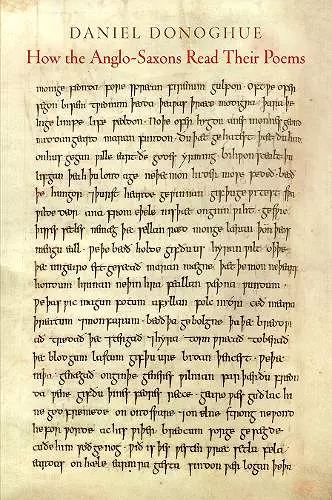How the Anglo-Saxons Read Their Poems
Format:Hardback
Publisher:University of Pennsylvania Press
Published:19th Apr '18
Should be back in stock very soon

Daniel Donoghue shows how the earliest readers of Old English poems deployed a unique set of skills that enabled them to navigate a daunting task with apparent ease.
The scribes of early medieval England wrote out their vernacular poems using a format that looks primitive to our eyes because it lacks the familiar visual cues of verse lineation, marks of punctuation, and capital letters. The paradox is that scribes had those tools at their disposal, which they deployed in other kinds of writing, but when it came to their vernacular poems they turned to a sparser presentation. How could they afford to be so indifferent? The answer lies in the expertise that Anglo-Saxon readers brought to the task. From a lifelong immersion in a tradition of oral poetics they acquired a sophisticated yet intuitive understanding of verse conventions, such that when their eyes scanned the lines written out margin-to-margin, they could pinpoint with ease such features as alliteration, metrical units, and clause boundaries, because those features are interwoven in the poetic text itself. Such holistic reading practices find a surprising source of support in present-day eye-movement studies, which track the complex choreography between eye and brain and show, for example, how the minimal punctuation in manuscripts snaps into focus when viewed as part of a comprehensive system.
How the Anglo-Saxons Read Their Poems uncovers a sophisticated collaboration between scribes and the earliest readers of poems like Beowulf, The Wanderer, and The Dream of the Rood. In addressing a basic question that no previous study has adequately answered, it pursues an ambitious synthesis of a number of fields usually kept separate: oral theory, paleography, syntax, and prosody. To these philological topics Daniel Donoghue adds insights from the growing field of cognitive psychology. According to Donoghue, the earliest readers of Old English poems deployed a unique set of skills that enabled them to navigate a daunting task with apparent ease. For them reading was both a matter of technical proficiency and a social practice.
"Donoghue does not shy away from asking the unanswerable questions, and his book is all the better for it . . . [He] engagingly and persuasively shows us that cognitive psychology has something to contribute to Old English prosody (and vice versa), and that not just Latin and Old Saxon but also medieval Arabic and modern Thai might change our perspective on Anglo-Saxon approaches to reading. Such a reappraisal of how the earliest texts in English were first experienced is a major contribution to the scholarship." * Times Literary Supplement *
"By putting into productive dialogue what have until now remained largely discrete schools of thought within Anglo-Saxon studies, How the Anglo-Saxons Read Their Poems offers an important and compelling reading both of the complex, interlocking, and interdependent constellation of cultural forces and graphic practices out of which Old English poetry emerges and of the means by and the degree to which its first, intended readers were so ably equipped to read it." * Speculum *
"A brilliant and daring achievement, one that ventures beyond most medievalists' scholarly experience." * John D. Niles, University of Wisconsin-Madison *
ISBN: 9780812249941
Dimensions: unknown
Weight: unknown
248 pages